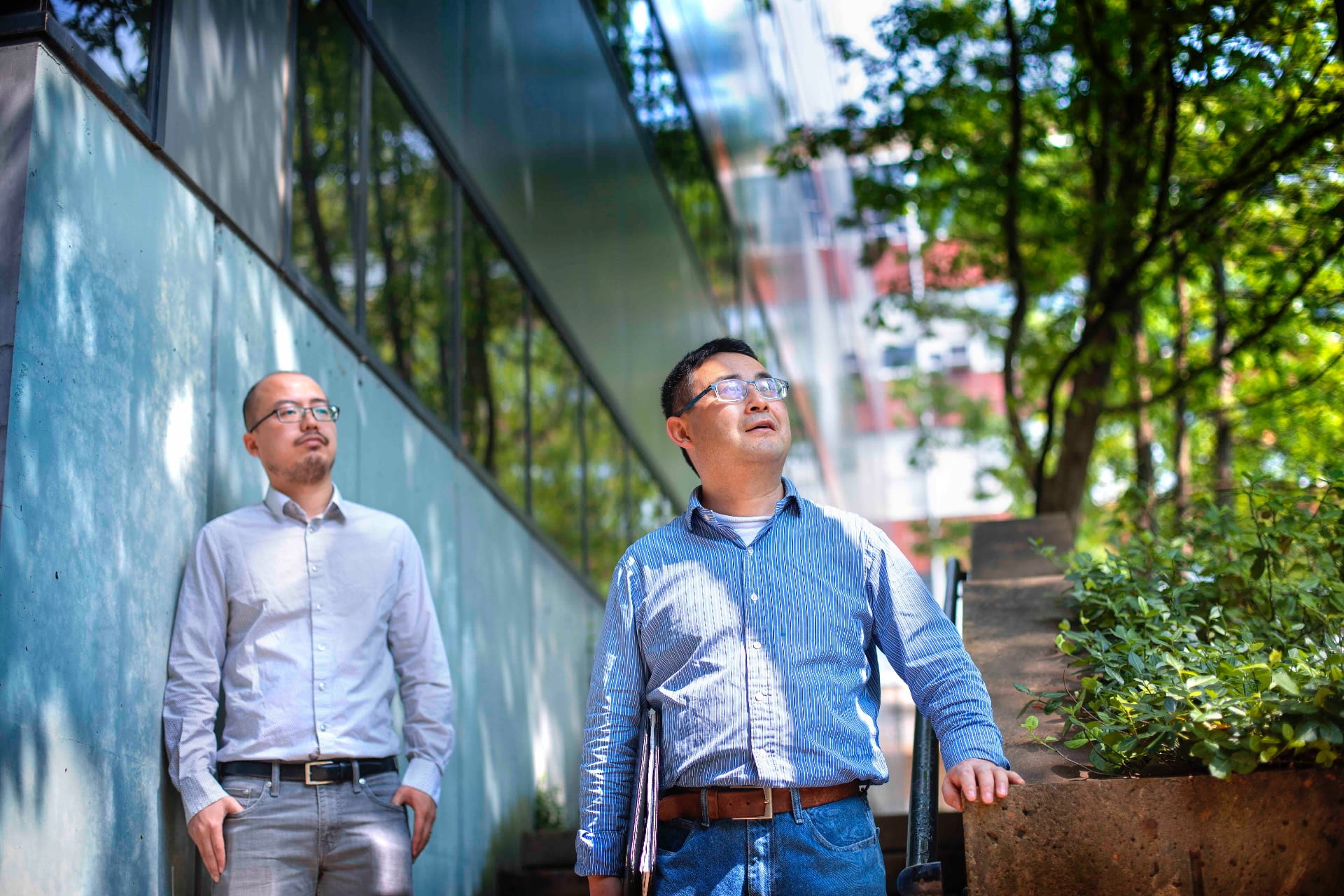Curbing diesel emission could reduce big city mortality

U.S. cities could see a decline in mortality rates and a related beneficial reduction in health care costs through midcentury if federal and local governments maintain stringent air pollution policies and diminish concentrations of diesel freight truck exhaust, according to Cornell research published in the journal Environment International.
“The U.S. must reduce emission in the transportation sector. By improving air quality through better policies and technology in the freight transportation sector, we can breathe better and save lives,” said senior author Oliver Gao, professor of civil and environmental engineering.
Freight transportation is a pillar of the U.S. national economy, but while long-haul trucks account for less than 6% of the vehicle miles traveled over U.S. highways, they account for about 40% of the emissions of air polluting particulate matter and about 55% of nitrogen oxides – the precursor to ozone in the atmosphere, the study said.
“People use their family cars some 10 to 12 years, and log about 120,000 miles over the car’s lifetime,” said Gao. “A diesel truck can stay on a fleet about 25 to 30 years and easily log a million miles.”
To reduce emissions by midcentury, the researchers said, truck manufacturers need to add advanced pollution-reduction technology to new trucks and retire older, highly polluting vehicles.
“By improving air quality through better policies and technology in the freight transportation sector, we can breathe better and save lives.”
Oliver Gao, professor of civil and environmental engineering
Freight trucks primarily use diesel engines, which are efficient and durable but emit fine-particulate exhaust, which poses a cancer risk 7.5 times larger than all other air toxins. Diesel exhaust is classified as a Group 1 (highest level) carcinogenic, according to the World Health Organization’s International Agency for Research on Cancer.
Gao and his colleagues modeled the public health impacts of restraining particulate matter, based on emission change for future air quality. They estimated improved health outcome (preventing 3,600 premature deaths nationally each year) and $38 billion annually in reduced health care expenditures.
In order to achieve emission reduction goals and the benefits in public health, stringent emission standards and fuel policies should be continuously and effectively implemented, the study said.
In addition, the societal benefits of reduced freight emissions are expected to largely exceed the implementation costs of such standards and policies. For instance, the total compliance in particulate restraint costs from 2011 to 2050 would be about $1.8 billion annually, which is about 5% of their calculated yearly health savings, $38 billion.
The researchers point out that employing a carbon tax on freight serves to increase oil prices and shifts at least 15% of freight to energy-efficient rail, reducing overall emissions and obtaining 9% more health benefits nationally.
While current federal regulations have emissions limits on new vehicles, the regulations do not affect vehicles already in use, Gao said. Aging trucks, however, can easily degrade from normal to high-emitting conditions. Eliminating super-emitting vehicles completely could further reduce long-haul freight emissions by nearly 70% and provide 20% more health benefits, the researchers said.
“Getting rid of the particulate matter is an important part of reducing air pollution from diesel truck emissions,” said Gao.
Other authors of “The Air Quality and Health Impacts of Projected Long-Haul Truck and Rail Freight Transportation in the United States in 2050” were lead author Shuai Pan, postdoctoral associate in civil and environmental engineering; postdoctoral fellow Anirban Roy, and Yunsoo Choi, associate professor of atmospheric chemistry, University of Houston; and ShiQuan Sun, Changsha University of Science and Technology, China.
This work was supported in part by the U.S. Department of Transportation’s Center for Transportation, Environment and Community Health, and the National Science Foundation.
http://news.cornell.edu/stories/2019/09/curbing-diesel-emission-could-reduce-big-city-mortality
Global & Sustainable Summer Program

Chang hosted the Global & Sustainable Summer Program from May 19 to May 25, 2019 on the UTEP campus. 13 students for University of Piura, Peru and 8 UTEP students participated in this program. Ph.D. student Okan Gurbuz gave a talk on LEED (Leadership in Energy and Environmental Design) and SmartCode on May 22, 2019. He also talked about CTECh projects during the visit to the Transportation Lab.
Using virtual reality for assessing perceptual responses by pedestrians and bicyclists to the built environment
CTECH researchers, Ricardo Daziano (Civil and Environmental Engineering and Systems Engineering) and So-Yeon Yoon (Design and Environmental Analysis), have been exploiting immersive built-environment scenarios to test how cyclists react to the differing types of cycling infrastructure. 28 experimental cycling conditions have been created and tested with the goal of identifying which infrastructure conditions would best encourage the adoption of active transportation for a healthful living while ensuring cyclists feel safe during their rides. At the end of the spring 2019 semester, 50 Cornell undergraduate students participated in the in-lab experiment.
Daziano and Yoon are currently analyzing the data they collected, which includes physiological signals that measure emotions of the participants. Because of the innovative tools that are being used to analyze demand for active transportation, even at this early stage this research is capturing attention in the transportation community. Daziano recently shared insights about the design and the benefits of the controlled experiments at invited talks at C2SMART, a Tier 1 University Transportation Center led by the New York University Tandon School of Engineering, and at Technion in Israel, as part of an academic visit funded by the Ruch Exchange Grant of the Jacobs-Cornell Institute.
Whereas CTECH supported the project that led to the design of the experimental conditions “Active transportation and the emotion-stress-health link: virtual reality for assessing perceptual responses by pedestrians and bicyclists to the built environment”, the team recently received additional CTECH funding for a project entitled “Immersive, highly realistic in-lab experiments of cycling route choices”. With this new support, Daziano and Yoon will now incorporate discrete choice games within the Virtual Reality experiments for improved, more realistic collection of stated choices to derive policy recommendations about characteristics of the built environment that create optimal incentives for the adoption of active transportation.
Electric vehicles would be a breath of fresh air for Houston

The American Lung Association’s 2019 “State of the Air” report released in April ranked Houston ninth nationally for worst ozone pollution and 17th for particle pollution.
Cornell researchers express hope for the future of Houston’s breathable air: by replacing at least 35% of Houston’s gasoline cars and diesel trucks with electric vehicles by 2040, Houstonians could breathe easier, live longer, and benefit from reduced health care costs.
“The built environment plays a significant role in affecting our daily life and health,” said H. Oliver Gao, professor of civil and environmental engineering and senior author of “Potential Impacts of Electric Vehicles on Air Quality and Health Endpoints in the Greater Houston Area in 2040,” published June 15th in Atmospheric Environment.
Gao, who directs Cornell’s Center for Transportation, Environment, and Community Health and is a fellow at Cornell’s Atkinson Center for a Sustainable Future, said that more than two-thirds of the oil imported by the U.S. is used for transportation.”
Shuai Pan, a postdoctoral associate in civil and environmental engineering, along with Gao and a team of chemists and engineers, modeled four scenarios using various levels of electric car adoption to see how Houston’s air quality and public health likely would respond two decades from now.
The researchers examined Houston’s daily 8-hour average ground-level ozone concentrations. The four scenarios they modeled were:
- keeping business-as-usual;
- moderate electrification (35% electric);
- aggressive electrification (70% electric); and
- complete turnover (35% electric, plus 65% potentially newer combustion and emission control technologies).
For surface ozone in 2040, the business-as-usual model showed elevated parts-per-billion concentrations. In the moderate and aggressive electrification scenarios, the models showed substantial improvement by reducing surface ozone parts-per-billion. With nearly complete turnover (about 95% reduction in emissions), that model showed a decrease of 3 to 4 parts per billion of surface ozone over most of Houston.
Currently, ozone “design value”, a regulatory statistic, is about 80 parts per billion in Houston; the modern standard is 70 parts per billion. “A decrease of 3 to 4 parts per billion of average ozone—from on-road mobile sources, for example—would be considered a large improvement,” Pan said.
The authors note that Houston’s population is projected to increase by 50% by 2040, which will increase motor vehicle activity and double the number of trucks. The Texas Transportation Institute projects the number of gasoline vehicles will increase by 30% to 50%, and the number of commercial trucks will increase by 40% to 80%.
“There are atmospheric implications of this,” Gao said. “Cities and regions are in need of policies that will help push electrification, so that we can gain health benefits and improve air quality.”
Pan said that even if its vehicle population almost doubles by 2040, Houston will likely have a much smaller emission factor than today, thanks to zero-emission technology at the systems level.
“Although Houston’s population is expected to significantly increase by 2040, we can apply new technology to reduce emissions, improve air quality, and think about health,” said Pan, who earned his Ph.D. in atmospheric science from the University of Houston in 2017.
The researchers note that although charging stations for electric vehicles will be added to the power grid, the effects of motor vehicle electrification on power plant resources were estimated and determined to be negligible as opposed to projected electricity generation. Hence, there is likely to be little need to build more power plants, the researchers said.
In their exhaust, gasoline and diesel vehicles emit nitrogen oxides—volatile organic compounds that react in the presence of sunlight to form ozone and increase detrimental fine particulates, elements known to harm human health.
If left unchecked, current ozone and particulate-matter levels would result in 122 more premature deaths annually throughout greater Houston by 2040. With moderate or aggressive electrification for cars and trucks, the numbers reflect air-quality improvement, with prevented premature deaths at 114 and 188, respectively. In the case of complete turnover, the number of prevented premature deaths per year around Houston shoots to 246.
“Mayors or policymakers—who care about the environment, public health and the associated cost of care—must advocate for electrification,” Gao said. “The knowledge is there, but we need mayors and city planners to be creative and innovative to design policies that would help the electrification of the transportation sector.”
Other contributors were Yunsoo Choi, associate professor of atmospheric chemistry, postdoctoral fellow Anirban Roy and doctoral candidate Ebrahim Eslami, all of the University of Houston; Stephanie Thomas, Public Citizen, a nonprofit public advocacy organization; and Xiangyu Jiang, State University of New York at Buffalo.